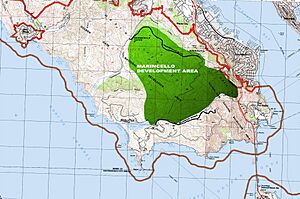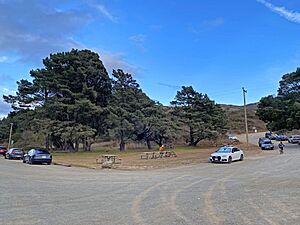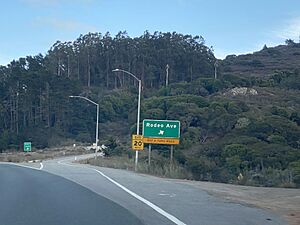Marincello facts for kids
Marincello was a big building project that never happened. It was supposed to be a new town built on the Marin Headlands in Marin County, California. This area has amazing views of the Golden Gate. The failure of Marincello helped Marin County decide to protect its beautiful open spaces instead of building on them.
Contents
The Story of Marincello
Before Marincello: The Marin Headlands
The Marin Headlands is a beautiful area near the ocean. In 1851, the US military bought this land. They wanted to build forts there to protect the coast. They built Forts Barry, Baker, and Cronkhite. They also planted trees to hide the forts. For a long time, the Headlands stayed mostly wild and natural.
By the 1950s, these forts were not as important anymore. The government started thinking about what to do with the land. People who cared about nature wanted the land to become a park. They wanted to keep it wild and open. They also wanted the old forts to become historic sites.
A Developer's Big Idea
In the 1960s, many new neighborhoods were being built across the United States. A developer named Thomas Frouge saw the Marin Headlands. It was very close to San Francisco. He thought it was the perfect place for a new town. He even said it was "the most beautiful location in the United States for a new community."
With help from Gulf Oil, Frouge bought about 2,138 acres (8.65 square kilometers) of land. He planned to build a new community called "Marincello."
Marincello was designed to be a huge town. It would have homes for 20,000 to 30,000 people. There would be 50 apartment towers, hundreds of houses, and townhouses. The plan also included a shopping mall and a large hotel.
Frouge promised that Marincello would be a well-planned city. He said it would look good and blend in with the natural landscape.
People Say "No!"
Many people in Marin County were worried. They felt that too much building was already happening. They saw Marincello as a final step that would ruin the area. They wanted to keep the land open and natural.
A small group of activists formed the Golden Gate Headlands Committee. They tried to stop the project. They collected 6,000 names on a petition. But the local leaders ignored them. Even a second petition was not accepted.
Some local newspapers supported the idea. They thought Marincello would be a "showcase" city. They believed it would help protect other natural areas in Marin County.
The Project Gets Started
In November 1965, Marin County officially approved Frouge's plan. Marincello was given the green light to start building. Large gates were put up at the entrance to Tennessee Valley. These gates marked the start of the new city. Bulldozers began to clear land. They built a wide, five-lane road up the mountain. This road was meant to be a main street for Marincello. It looked like the new city was definitely going to be built.
Legal Problems Begin
Even before the project was approved, legal issues started. In June 1965, Frouge was sued. The problem was about a planned street entrance to Marincello. This entrance would have gone through private property. It was important because it would have given easy access to US-101 and the Golden Gate Bridge. But it would have brought a lot of traffic to a small residential street. A court order stopped this entrance from being built.
By 1966, the cost of Marincello was growing much larger than planned. The leaders of Gulf Oil, who were paying for the project, started to have doubts. There were disagreements within the company. Building stopped in 1967.
This pause allowed three lawyers, Douglas Ferguson, Bob Praetzel, and Marty Rosen, to step in. They were upset about how the project was moving forward. They filed a major lawsuit against Marincello.
They represented the City of Sausalito. They argued that Marincello's zoning (the rules for how land can be used) was wrong. They said the public only had six days to review the zoning, instead of the ten days required by law. This small detail led to finding many other mistakes in the zoning plans.
By 1970, Gulf Oil was ready to restart the project. But then, they faced a big defeat. The court ruled that the entire project was improperly zoned. This meant they had to throw out all their plans and start over. The very next day, Marin County announced they would no longer support Marincello.
Marincello Dies Out
In the late 1960s, the government was studying the idea of creating a national park around the Golden Gate. This park would include places like Alcatraz and the Presidio. Soon, they realized that the Marin Headlands was a very important area for this new park.
In early 1970, Huey Johnson, who worked for The Nature Conservancy, talked to Gulf Oil. He wanted them to sell the land for the park. After Gulf Oil lost their lawsuit, selling the land became a good option for them. In 1972, the land was sold for $6.5 million. It then became part of the new Golden Gate National Recreation Area. The Marincello project was finally over, without a single building ever being built. In 1976, the Marincello gates were taken down.
Marincello Today
Today, the Marin Headlands is a protected area with thousands of acres of open land. But you can still see some parts of the Marincello project. The main road that was built is now a dirt path. It is called the "Marincello Trail." It is a popular place for hiking, biking, and horse riding. This trail connects to other paths that would have been roads in the planned city.
If you drive south on US-101, you might see an exit for Rodeo Ave. This exit leads nowhere! It is a short ramp that ends at a dirt road. This road is now closed to cars. If Marincello had been built, this dirt road would have been a main road into the city. Instead, it is now a trail for walkers. It connects with the Marincello Trail at the top of the hill.
Today, the Headlands are part of the Golden Gate National Recreation Area. This park gets 16 million visitors every year. It is one of the most popular national park areas in the country.
In 1972, three people who helped stop Marincello – Huey Johnson, Douglas Ferguson, and Martin Rosen – started an organization. It is called The Trust for Public Land. This group works to create parks and protect lands across the United States.
Images for kids








